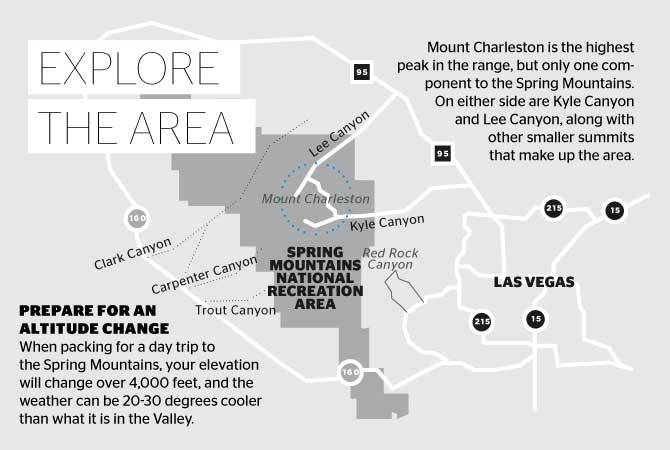As Las Vegans, we’re spoiled. We get the best of everything: great weather, celebrity restaurants, every show imaginable—the list goes on and on. But when you already live in one of the top getaway destinations in the country, where do you get-away to? Cue: the Spring Mountains. Yes, during the winter months those snowy peaks looming over the Valley are prime daytrip destinations for skiing, snowboarding and even tubing.
What should I bring?
Skiing and snowboarding clothes: The trick to building a proper snow-sports outfit is layering. You’ll need to stay warm but not get overheated, so being able to add and subtract layers as needed is crucial. Start with tight-fitting base layers and then work your way out.
•Long underwear and a light, merino wool undershirt are a great place to start. For your under layer, look for materials that will retain heat and help with sweat wicking, like merino wool or polyester blends.
•From there, add a sweater, turtleneck or hoodie (being able to zip and unzip can help with temperature control).
•Over that, you’ll need thick, waterproof ski pants and a waterproof jacket. For snowboarders especially, look for longer jackets that will cover your butt.
Accessories: Waterproof socks need to be a top priority. They should be thick and woolly, but not too bulky. And definitely don’t wear two pairs. If your socks are too bulky or you’re wearing multiple pairs, it can end up limiting the blood circulation in your feet, AKA you’ll lose sensation and your toes will feel even colder.
You’re also going to need:
•Snow boots
•A warm hat or beanie
•Goggles or sunglasses
•Neck gaiter
•Thick, waterproof gloves
Gear: You’re going to need skis, ski boots, ski poles or a snowboard and snowboard boots.
Either bring your own or rent from the resort, but try to avoid borrowing gear from friends. For either skiing or snowboarding, the right fit is essential. If your boots are too tight or too loose, or the bindings are improperly adjusted, even just slightly, you’re going to have problems. Resorts will be able to professionally fit your boots to ensure that they’re just right.
And be sure to wear a helmet. Ideally everyone, but especially children, should have a helmet on while on the slopes.
Other tips:
If it’s your first time on the slopes, do yourself a favor and take a lesson. Skiing and snowboarding with friends is great, but it can become an intuitive process for experienced riders, which means they might struggle when it comes time to explain the basics.
Don’t forget sunscreen. Trust us, regardless of your complexion or affinity to the desert sun, the UV rays are at their strongest on snowy, mountain peaks. Save yourself the pain (and the inevitable raccoon tan lines) and wear waterproof SPF 40 or higher. Reapply every 2 hours.
Prepare for an altitude change. When packing for a day trip to the Spring Mountains, it’s important to remember that, while close in proximity, it can be a completely different world up there. Your elevation will change over 4,000 feet, and the weather can be 20-30 degrees cooler than what it is in the Valley. Even if you’re just heading up for the afternoon, a well-vetted pacing list can make all the difference.
For people who are sensitive to the altitude change, drinking lots of water and eating nutritious food (especially foods rich in potassium and carbohydrates—bananas are a great option) will help eliminate any discomfort. Keeping ibuprofen and ginger chews on hand can also help.
